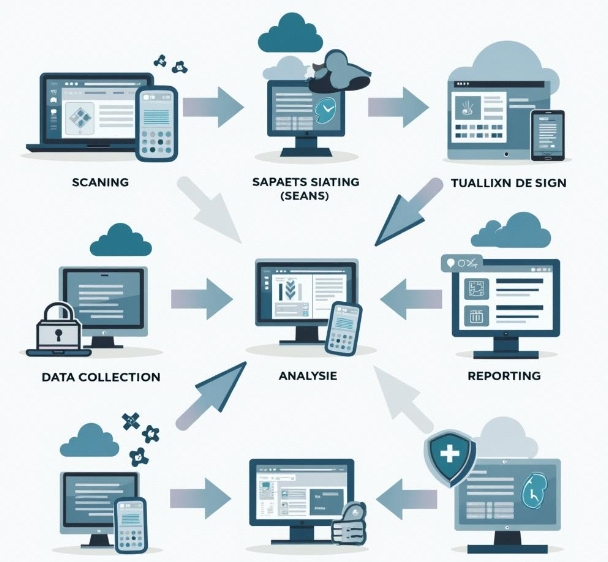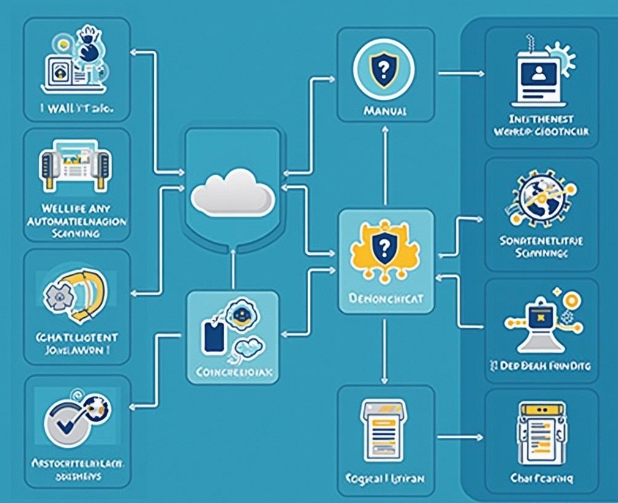Vulnerability Scanning: The Security Line of Defense in the Intelligent Era
- latest articles
- 1.DApp Development & Customization: Merging Diverse Market Needs with User Experience 2.Analysis of the Core Technical System in DApp Project Development 3.How to achieve cross-chain interoperability in Web3 projects? 4.How does the tokenization of points reconstruct the e-commerce ecosystem? 5.How to Set and Track Data Metrics for a Points Mall? 6.What is DApp Development? Core Concepts and Technical Analysis 7.Inventory of commonly used Web3 development tools and usage tips 8.Development of a Distribution System Integrated with Social E-commerce 9.Six Key Steps for Businesses to Build a Points Mall System 10.What is DApp Development? A Comprehensive Guide from Concept to Implementation
- Popular Articles
- 1.Future Trends and Technology Predictions for APP Development in 2025 2.Analysis of the DeFi Ecosystem: How Developers Can Participate in Decentralized Finance Innovation 3.From Zero to One: How PI Mall Revolutionizes the Traditional E-commerce Model 4.DAPP Development | Best Practices for Professional Customization and Rapid Launch 5.Recommended by the Web3 developer community: the most noteworthy forums and resources 6.From Cloud Computing to Computing Power Leasing: Building a Flexible and Scalable Computing Resource Platform 7.How to Develop a Successful Douyin Mini Program: Technical Architecture and Best Practices 8.Shared Bike System APP: The Convenient Choice in the Era of Smart Travel 9.How to Create a Successful Dating App: From Needs Analysis to User Experience Design 10.From Design to Development: The Complete Process of Bringing an APP Idea to Life
In the wave of modern informatization, the rapid development of the internet has made cybersecurity issues increasingly complex and severe. Especially in the era of intelligence, the widespread application of new technologies such as the Internet of Things, artificial intelligence, and big data has diversified and smartened attack methods, making traditional defenses inadequate against these new challenges. Therefore, vulnerability scanning, as a critical component of information security protection, is becoming increasingly important. Through vulnerability scanning, businesses and individuals can promptly identify security flaws in their systems, thereby avoiding potential cyberattacks and building a robust security line of defense.
I. Definition and Role of Vulnerability Scanning
Vulnerability scanning refers to the use of specialized tools to automatically scan computer systems, network devices, applications, etc., to check for known security vulnerabilities. These tools typically scan operating systems, network protocols, web applications, etc., to identify weaknesses that attackers could exploit. The primary role of vulnerability scanning is to help security personnel detect and patch vulnerabilities before attackers discover and exploit them, thereby reducing the occurrence of security incidents.
1.1 The Role of Vulnerability Scanning
In the intelligent era, cyberattack methods have gradually shifted from traditional simple intrusions to more complex and covert attack patterns. For example, zero-day vulnerabilities refer to flaws that have not yet been discovered or fixed by vendors; these are often exploited by attackers for highly effective attacks. Vulnerability scanning is designed to detect these undiscovered vulnerabilities, helping organizations identify and fix them early through regular scans and real-time updates to vulnerability databases.
1.2 The Necessity of Vulnerability Scanning
In modern cybersecurity, the necessity of vulnerability scanning is self-evident. As the complexity of network environments continues to increase, relying solely on manual analysis and patching of vulnerabilities has become insufficient. Vulnerability scanning tools provide continuous, systematic vulnerability detection, helping organizations respond to security threats early and avoid potential financial losses, data breaches, and other security incidents. Moreover, in the increasingly complex offensive and defensive landscape of the intelligent era, vulnerability scanning not only identifies known vulnerabilities but also predicts and discovers new security risks, offering more efficient defense capabilities for businesses.
II. Development of Vulnerability Scanning Technology
2.1 From Manual to Automated
The evolution of vulnerability scanning technology has progressed from manual detection to automated detection. In the early days, security experts relied on manual inspections and code reviews to identify vulnerabilities in systems—a method that was not only inefficient but also prone to oversight. With the advancement of information technology, automated vulnerability scanning tools gradually replaced manual checks. These tools can automatically scan entire network systems, identify potential vulnerabilities, and generate reports, significantly improving efficiency and accuracy.
2.2 Intelligent Vulnerability Scanning
Entering the intelligent era, vulnerability scanning technology has reached a higher level of development. Traditional vulnerability scanning tools primarily rely on predefined rules and signature databases for detection. While effective, this approach has limitations. For instance, traditional scanners might miss complex vulnerabilities or new types of attacks. With the development of artificial intelligence technologies, intelligent vulnerability scanning has emerged. Using technologies like machine learning and deep learning, intelligent vulnerability scanning tools can continuously learn and optimize, predict potential security threats, and proactively address vulnerabilities. This intelligent vulnerability scanning technology can identify vulnerabilities more efficiently and accurately, even taking preventive measures before attacks occur.
2.3 Integration of Vulnerability Scanning and Vulnerability Management
As the cybersecurity landscape evolves, vulnerability scanning is not just about discovering vulnerabilities; effectively managing the identified vulnerabilities has also become crucial. Vulnerability management includes categorizing vulnerabilities, assessing their priority, and implementing remediation measures. Only under an effective vulnerability management system can the value of vulnerability scanning be maximized. Currently, more and more vulnerability scanning tools are integrated with vulnerability management platforms, forming a closed loop that enables organizations to manage the vulnerability remediation process more efficiently and ensure the continuous effectiveness of their security defenses.

III. Challenges of Vulnerability Scanning in the Intelligent Era
3.1 The Sharp Increase in the Number of Vulnerabilities
With continuous technological advancements, the number of vulnerabilities has exploded. In the intelligent era, the widespread use of technologies such as IoT devices, smart terminals, and autonomous driving has significantly increased system complexity, also introducing more vulnerabilities. Hackers can exploit these vulnerabilities to launch attacks on numerous devices and systems in a short time, causing substantial damage. Therefore, vulnerability scanning tools need enhanced scanning capabilities to handle vulnerability scanning tasks across more devices and more complex systems.
3.2 Discovery and Response to Zero-Day Vulnerabilities
Zero-day vulnerabilities are a key target for hackers, referring to attacks that exploit vulnerabilities not yet patched by vendors. The existence of zero-day vulnerabilities poses greater challenges for vulnerability scanning. Traditional vulnerability scanning tools cannot identify unknown vulnerabilities, making effective response to zero-day vulnerabilities a major challenge for the technology. Currently, intelligent vulnerability scanning tools, by incorporating technologies like machine learning, can to some extent identify unknown vulnerabilities and take preventive measures in advance.
3.3 Diversification of Security Threats
The intelligent era has not only changed the application scenarios of vulnerability scanning technology but also made network security threats more complex. For example, attackers might use artificial intelligence technologies to automate attacks on vulnerabilities, making defense systems harder to counter. Additionally, with the development of big data analytics, attackers can conduct precise attacks using massive datasets, increasing the difficulty of defense. In response to these new security threats, vulnerability scanning tools need continuous innovation and optimization to maintain efficient security protection capabilities in complex network environments.
IV. Application of Vulnerability Scanning in Enterprise Security
In enterprise security management, vulnerability scanning has become an essential component. By conducting regular vulnerability scans, organizations can promptly identify and fix security vulnerabilities in their systems, effectively reducing the risk of being attacked. Furthermore, vulnerability scanning is not only applicable to IT infrastructure security but also plays a role in emerging fields such as cloud computing and big data.
4.1 Network Security Protection
In an enterprise's network security protection system, vulnerability scanning plays a crucial role. Through vulnerability scanning, organizations can identify various potential security vulnerabilities in their networks, such as unpatched operating system vulnerabilities, insecure network configurations, and vulnerable applications. Regular vulnerability scans help detect these vulnerabilities in time, preventing hackers from infiltrating the corporate network and stealing critical data through these flaws.
4.2 Application Security
With the proliferation of applications, application vulnerabilities have become a significant avenue for hacker attacks. Through vulnerability scanning, enterprises can promptly identify security flaws in their applications and fix them to prevent attacks. During the development phase, vulnerability scanning tools can also help developers detect security issues in the code early, ensuring that applications are highly secure before deployment.
4.3 Cloud Security Management
In today's increasingly popular cloud computing, cloud security presents new challenges for enterprises. The application of vulnerability scanning in cloud environments helps organizations identify potential vulnerabilities in cloud services, promptly patch them, and guard against possible security threats. Vulnerability scanning in cloud environments can scan not only the vulnerabilities of the cloud platform itself but also the security of cloud applications and services, ensuring that corporate data is effectively protected in the cloud.

V. Future Development Trends
With the advent of the intelligent era, vulnerability scanning technology will continue to advance towards higher levels of intelligence. In the future, vulnerability scanning tools will not only be limited to detecting known vulnerabilities but will also be able to identify and respond to new attack methods in real time. The integration of artificial intelligence and big data technologies will make vulnerability scanning tools more intelligent and precise, capable of predicting and preventing potential security threats.
5.1 Widespread Application of Intelligent Vulnerability Scanning
With the continuous advancement of artificial intelligence technologies, intelligent vulnerability scanning will be more widely applied across various industries. Enterprises will use intelligent vulnerability scanning tools for comprehensive security protection, not only identifying known vulnerabilities but also proactively discovering potential threats. Additionally, intelligent vulnerability scanning will be able to automatically adjust scanning strategies based on different attack methods, improving detection efficiency and accuracy.
5.2 Automated Vulnerability Remediation
In the future, vulnerability scanning tools will not only detect vulnerabilities but also integrate with automated remediation systems to achieve automatic vulnerability fixing. This automated vulnerability remediation technology will significantly enhance an organization's security protection capabilities, shorten the time required for vulnerability patching, and reduce the risks associated with manual operations.
VI. Conclusion
In the intelligent era, vulnerability scanning, as a vital component of the information security defense line, is crucial for ensuring network security. With technological advancements, vulnerability scanning tools are becoming increasingly intelligent and automated, helping organizations and individuals effectively counter various security threats. However, the cybersecurity landscape remains severe, and vulnerability scanning is only one part of the defense system. Only when combined with other security measures can a robust security line of defense be truly established to protect information security.
-

How to Use App Development to Boost Conversion Rates on E-commerce Platforms
With the widespread adoption of smartphones and the rapid development of mobile ···
-

How APP Development Facilitates Digital Transformation and Innovation
With the rapid advancement of information technology, digital transformation has···
-

App Store Optimization and SEO Strategies in App Development
In today's rapidly evolving mobile internet landscape, apps have become essentia···

 Blockchain
Blockchain










